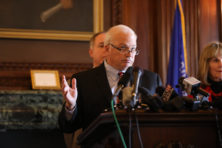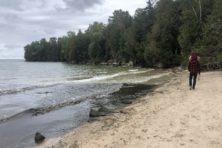It’s A Duck!
- Share
- Tweet
- Pin
- Share
The “Hoosier Poet,” James Whitcomb Riley, long ago made the now famous observation: “When I see a bird that walks like a duck, and swims like a duck, and quacks like a duck, I call that bird a duck.”
Three coincidental trends point to an ominous approaching meteorological “duck.” These are: the number of us humans occupying Planet Earth; concentrations of atmospheric carbon dioxide; and average global temperature. They are going up and up and up together. I would prefer to think of these concurrent trends as just unrelated coincidence. But let’s take a closer look.
It walks like a duck: The 20th century started in 1900 when the growing human population had reached 1.6 billion. It ended in 2000 with our numbers having soared to 6.1 billion. This is nearly a four-fold increase within a single century, contributing to evergrowing demands for more food, water, fuel and housing. Today our numbers have swelled to more than 7 billion, and the growth curve continues on a steep upward climb. It will take less than a dozen years to add yet another billion. Meanwhile the Earth isn’t getting any larger. It’s been said that it would require three more planet Earths today to sustain the world’s population if everyone enjoyed our standard of living. We have a problem.
It swims like a duck: In 1700 just before the start of the Industrial Revolution, atmospheric carbon dioxide was at about 270 parts per million (ppm). That’s when we started burning serious amounts of coal, releasing long sequestered ancient carbon into the atmosphere. Atmospheric carbon began to rise. The last several decades have seen the largest increases. The concentration of carbon dioxide has now topped 400 ppm for the first time in millions of years. This is a wake-up call. The rates continue to spiral upward, with emissions mainly from combustion of coal, oil, natural gas and wood.
It quacks like a duck: Along with this increase in population numbers and atmospheric greenhouse gases, there is also a steady increase in global temperatures. Nine of the 10 warmest years on record have occurred since 2002. The warming trend has had an impact. All over the planet, glaciers are retreating. In Glacier National Park, only a few glaciers remain, and soon there will be none. Coincident with this fact, sea level is steadily rising. During the past hundred years, it has risen by more than a millimeter each year. Currently the rise is between 2 and 3 millimeters per year.
I think we can call it a duck, or more explicitly “human-caused global warming.” It will take a global effort to start cleaning up our mess. It’s been said that we can’t afford to reduce carbon pollution, that we need to find more oil. Truth is, we can’t afford NOT to clear the air (and the water). Since posterity can’t be here to look out for their best interests, it’s up to us. We are creating the future by our actions now.
The International Panel on Climate Change (made up of scientists from around the globe) attributes recent climate change to human activities, calling it 95 to 100 percent certain. A recent poll by the Pew Research Center found a chasm separating science from the general public when it comes to acceptance of human-caused global warming. Interestingly, the U.S. Senate reflects this, with 98 of 100 senators agreeing that the globe is warming, but only half consider it human caused.
The Union of Concerned Scientists points out that global warming is already having significant and costly effects on our communities, our health, and our climate. Impacts include damage to coastal cities, longer and more damaging wildfires, crop failures, more frequent and intense heat waves, more extreme weather, heavier precipitation and flooding, destruction of coral reefs, disruption of food supplies, plant and animal range shifts, and the list goes on. Sea level has already risen eight inches since the 19th century. We must accept responsibility and take action.
We have to increase renewable energy, decrease use of fossil fuels, and improve energy efficiency.
Leave it to James Whitcomb Riley (in his classic poem, “When the Frost is on the Punkin”) to appreciate the “coolness” of our world. That beautiful end of summer is worth preserving.
“But the air’s so appetizin’, and the landscape through the haze
Of a crisp and sunny morning of the airly autumn days
Is a pictur’ that no painter has the colorin’ to mock –
When the frost is on the punkin and the fodder’s in the shock.”

Dale Goodner was a naturalist and supervisor for Peoria Park District in Illinois. After 34 years, he retired and returned to northeast Wisconsin in June 2010. He now lives in Algoma, with his wife, Mary. They volunteer for various organizations, including Algoma Tree Committee, Bird City Wisconsin, Door County Land Trust, Door County Wild Ones and Whitefish Dunes State Park.


